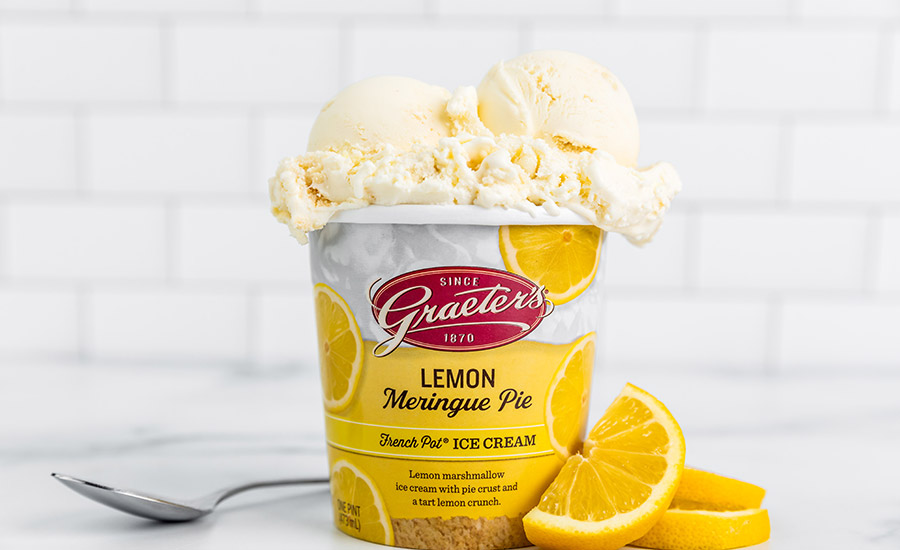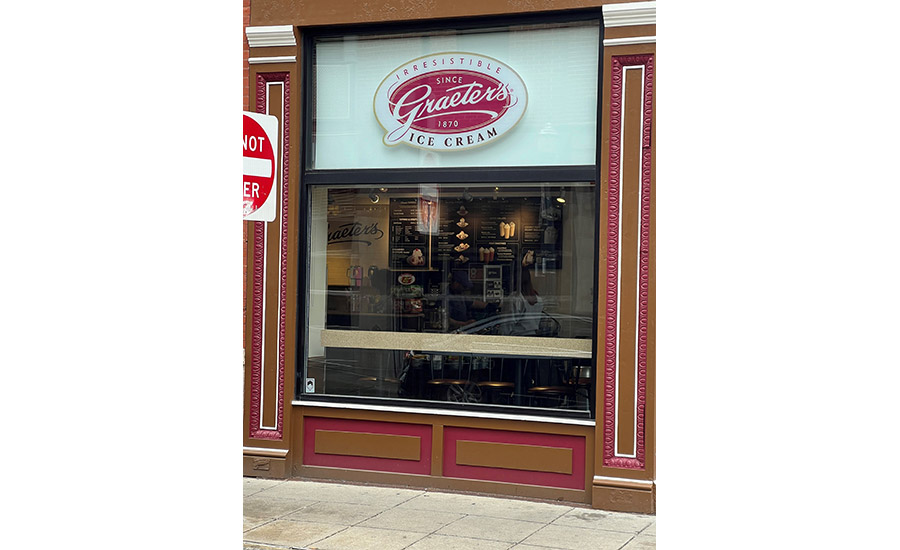Graeter’s proves indulgent ice cream still very much in style
Company’s high-end, indulgent products continue to win over consumers.

Article photos by Graeter's and Brian Berk
Graeter’s Ice Cream has achieved something few companies have. It is synonymous with the city it has served for the past 154 years: Cincinnati.
When many locals think of the Queen City, the name Graeter’s is sure to be mentioned. NBC, recognizing this connection, prominently featured Graeter’s right before a commercial break during a 2023 Cincinnati Bengals “Sunday Night Football” game.
Even more recently, on April 7, when the New York Mets visited Cincinnati to play the Reds baseball team, Mets broadcaster Gary Cohen exclaimed during the game broadcast, “How can you do a Cincinnati profile and not talk about Graeter’s Black Raspberry Chocolate [Chip] ice cream?”
Robert Graeter, fourth-generation member of the Graeter Family and company vice president, takes the excellent reputation the ice cream processor has earned over the years in not only Cincinnati — but the surrounding Midwest region as well — seriously.
“We are a family business. A city is made up of communities, which all used to have a candy store, movie theater, bakery, and butcher shop. We have always been part of that,” Graeter tells Dairy Foods. “My great-grandmother’s vision was to be a part of every community, and we had stores in 17 communities at one time. We have grown up with Cincinnati. We have always made a quality product and never varied from that.”
In addition to its 30,000-square-foot plant, located in the Bond Hill section of the Queen City — a few miles north of downtown Cincinnati — Graeter’s today operates 56 retail locations throughout the Midwest. During a 20-minute walk in downtown Cincinnati, Dairy Foods discovered two of these locations, one located in the heart of the city and one in the popular OTR (Over-the-Rhine) neighborhood. The stores of course sell many of Graeter’s popular flavors, including its extremely successful Black Raspberry Chocolate Chip, as well as seasonal flavors and company swag.
“Eighteen to 20% of what we sell is one flavor: Black Raspberry Chocolate Chip. It is beautiful and ends up in a lot of pictures,” Tim Philpott, vice president of marketing, reports. “But we have plenty of other staples, like Cookie Dough, Chocolate Chip, Chocolate Chocolate Chip, Cookies and Cream with Oreos in it, and more. We have some flavors you might expect, but they are the most popular.”
Retail is a big part of Graeter’s success, the company adds. “Typically, processors do not have as many retail locations as we do,” Graeter says. “If we were just an ice cream processor, I am not sure we would have survived all these years. Our customers have always supported us. We build great stores, provide excellent customer service, and offer an excellent experience. That has cemented us within the community over multiple generations.”
Graeter’s today is part of the fabric of the community, as everyone grew up with its products, and people have stories about their grandparents taking them to stores to purchase its ice cream. “Everyone takes their kids, and those kids grow up and take their kids to our stores,” Graeter notes.
The connection to the Cincinnati community runs even deeper, Philpott states.
“We are associated with the Reds, Kings Island amusement park, The Cincinnati Zoo, and more,” he states. “The people who curate those experiences come to us and want us to be a part of it. We have a prominent location at the Reds games where we sell scoops of ice cream next to Skyline Chili for example. The Reds highlight local businesses down the third-base line. We are invited there and want to be a part of it. We are fortunate to have an excellent history.”
Storied history
Robert Graeter’s great-grandparents started Graeter’s Ice Cream because they wanted to be “in control of their destiny,” he maintains. “They worked extremely hard. It was essentially a 365-day-a year business. They had three holidays: Thanksgiving, Christmas and New Year’s Day.”
The hard work paid off as Graeter’s expanded to several stores and success became so evident that it franchised the business. However, Graeter’s later repurchased those franchised locations because it was simpler, and safer, to manufacture ice cream in one location, Graeter notes.
Ice cream sales were not always hot during the past 154 years. This was true during and after war periods, so Graeter’s diversified by commencing a bakery business to provide essential foods for families. The bakery business helped Graeter’s to stabilize the business, while selling ice cream during these leaner times, which still proved to be popular during certain activities, such as after going to the theater.
Despite this diversification, Graeter’s has not changed its core philosophy to provide a high-quality product, great customer service and making sure employees serve up a smile upon a customer’s entrance into one of its stores.
Simply stated, customers trust the Graeter’s brand, which also extends to its sales at supermarket chains, including Kroger. “Be consistent, positive, and reliable,” Graeter says.
“Something Graeter’s also does is recognize the positive part it plays in people’s lives. Our community can be zealots about our product. They are counting on us to not let them down,” adds Tom Kunzelman, vice president of manufacturing. “Eating ice cream is a great experience. But we are also about life experiences. The people in our stores come after a recital or a soccer game. We recognize the part we play to bring joy.”
Graeter’s is an affordable luxury consumers can always count on, Kunzelman continues. “We wear our Graeter’s logo apparel in public, and people will stop us to tell us a story about an experience they had. We honor that tradition and it drives our focus,” he says. “Anytime someone asks us what we do, we answer we work for Graeter’s and it always brings on a great conversation. That is why we do what we do.”
For the most part, Graeter’s business is steady. Of course, Graeter’s will vary its flavor offerings at times, but the company continues to focus primarily on selling ice cream. The company does have sorbet and animal-free options for customers who prefer that, but the focus on indulgent ice cream remains the same.
“We do not think about how to make a few more nickels or doing something 20% faster or with less staff. It is always about making great ice cream,” Kunzelman stresses.
“We are not run by spreadsheets,” Graeter adds. “We are not looking at the short term. We are not looking at selling the business. We are looking at the next 50 to 100 years to continue to give this great experience to the community.”

“Employees, visibly seeing the family commitment, make a huge investment in the company,” Kunzelman relays. “If something is ever not right, every one of us is committed to make it right. Every meeting I sit in, I am amazed at the level of engagement,” he states. “We do not have any clock watchers or clock punchers around here. We take a lot of pride in making the business better.”
In addition to this employee commitment, Graeter’s can take solace in the fact the next generation is expected to be fully involved in the business for many years to come. This includes Graeter’s daughter, who already works at the company, as well as his cousin’s son, with others likely to join the business in the future.
French Pot process
Graeter’s separates itself from the competition with its unique French Pot process. It uses a two-gallon batch process to freeze the product that is a slow, methodical way of processing ice cream, but yields a tremendous reward with smooth, creamy ice cream.
“It provides a density you just do not get [with other ice creams]. We probably give more value to ingredients than anybody,” Graeter reveals. “It is intensive from a labor standpoint. It is not an automated system. You do not press a button and get more product. It’s handcrafted. We are beneficiaries and restrained by our process.”
Graeter adds the ice cream processor does no co-packing, nor does it offer a “value” brand with a less intensive process. In turn, employees learn the French Pot process and become “artisans.”
“Tom [Kunzelman] is very successful at building a skill block system that teaches an artisanal and teamwork approach. It is truly a team effort to make the product we have,” Graeter asserts. “Tom has taken us to the next level by communicating to the team the passion and care that is needed to maintain the ice cream’s consistency.”

Kunzelman adds there were initially questions if Graeter’s could scale its French Pot process when it moved from downtown Cincinnati to 1175 Regina Graeter Way — named after Bob Graeter’s great-grandmother — in the Bond Hill section of Cincinnati in 2010.
“Our old plant had 12 French pots. We wondered if we could expand it due to the labor intensity of the process,” he notes. “We have about 27 employees on the floor, and during their shift, they will probably churn about 3,000 to 3,500 gallons of ice cream. That is a small amount of ice cream for that much labor.”
Slow and steady wins the race
Graeter confirms the ice cream manufacturer is not looking to grow its business rapidly. Instead, its focus is to grow slowly by adding additional retail outlets to sell its products.
“We may have gone too far with the retail grocery expansion, pushing the plant too hard, so we wanted to slow it down,” Graeter reveals. “We focused on who our great partners are and have the clientele who would support our high-end product. We are not trying to compete on price. We compete on quality. Our growth plan is slow, steady, and sustainable.”
Kunzelman adds that when Graeter’s opened its new plant, it expected it would take 20 years to reach operating capacity. However, it took only eight years to do so.
“We looked into expanding the plant, but it was decided it was best to refocus on who we are supplying,” he says. “We looked more at growing our retail outlets, because profitability is difficult at grocery chains, as it involves shipping our products all over the country. …We are not in as many doors as we used to be, but we are in better doors.”
“We are in a great position,” Kunzelman stresses.
Future of ice cream
Any company who has been in business for 154 years has seen plenty of ups and downs in terms of consumer trends. Ice cream is clearly no different. Graeter’s is all about indulgence, something of which can see brief market fluctuations, if there is a big consumer health trend for example, but its long history proves ice cream’s tremendous staying power.

Consumer trends can also be a big boon as well. The company had a big spike in sales during the COVID-19 pandemic because it continued to operate and ship its ice cream, Graeter notes.
“Consumers have shifted to price sensitive products in the past year or so, but I see it shifting back again,” Graeter says. “They are not going to buy junk when they can buy a great product.”
Graeter stresses he does not see any demise in indulgence products in the future.
Kunzelman adds trends come and go, such as big rises of frozen yogurt and gelato products seen in the past. These products have their niche, but largely do not affect ice cream indulgence products.
“We have seen products that contain 300 calories per pint. Things ebb and flow,” Philpott continues. “It is hard to do what we do. People will have interesting stories and brands can be successful on some scale. But for people who know the difference [between certain products and high-end indulgence products]. We always survive the test.”
“Cool new ice cream products will come out and be endorsed by social media influencers, resulting in one-time consumer purchases,” Philpott notes. “We have had many social media successes for short-term collaborations, but our guests tend to buy our flavors over and over again. We are not a one flavor or one-time purchase company.”
Graeter stresses the Cincinnati ice cream processor is not a pint company. It is an experience company.
“Our foundation is a solid, great product. But we go beyond there. We have a full-service ice cream fountain, shakes, smoothies, sundaes, and even sodas.”
High-end indulgence products will not be going away any time in the new future, Graeter concludes.
“When consumers want a good experience, we want to be part of their lives,” Graeter relays. “The market wants that. We are fortunate that our sales have been good.”
Looking for a reprint of this article?
From high-res PDFs to custom plaques, order your copy today!







